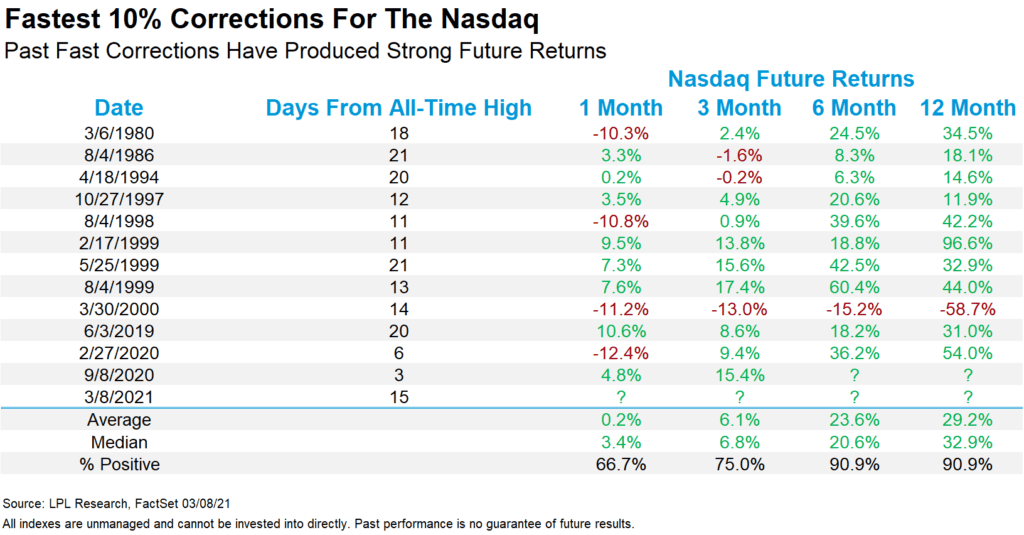Top Story
Why Higher Rates Aren’t Bad For Stocks
In this week’s new Market Signals podcast and video, Chief Market Strategist Ryan Detrick and Equity Strategist Jeffrey Buchbinder discuss why higher rates historically haven’t been bearish for stocks and don’t think they will be this time either.
Daily Insights
Nasdaq 100 opens firmly higher after entering correction territory on Monday
- European markets are modestly higher in midday trading with the German DAX Index
- Asian stocks mostly higher overnight despite weakness in Chinese markets
- Japan’s gross domestic product (GDP) rose an annualized 11.7% in the fourth quarter
Nasdaq in correction mode
It took only 15 trading days for the Nasdaq to go from an all-time high to down 10%, one of the fastest corrections ever.
- At 15 days, this ranks as the 8th fastest 10% correction ever for the Nasdaq.
- The two fastest corrections ever both took place during the historically volatile year of 2020.
- Looking at the previous fastest 10% corrections, future returns have been extremely strong.

Rising interest rates are a global phenomenon
Similar to the U.S.’s story of increasing growth and inflation expectations, non-U.S. interest rates have started moving higher.
- Countries that were more aggressive in virus containment and vaccine deployment have seen the largest increase in yields this year.
- The U.S., Canada, and Germany are countries that haven’t seen yields fully retrace their pandemic declines, which suggests that yields could continue to rise to these previous levels as further vaccine deployment takes place.
- The global rise in rates has been for good reasons (primarily increased growth expectations), but a rise in rates that happens too quickly or gets too high could impact an uneven global economic recovery.
- For more on our view of rising global interest rates, read today’s LPL Research blog, available at 12pm ET. https://lplresearch.com/
Small business optimism rises
The NFIB Small Business Optimism Index climbed modestly from 95.0 to 95.7, below the consensus of 97, but the first advance after three months of declines.
- The National Federation of Independent Business’ (NFIB) report showed some concern about a tightening job market and anticipation of increased price pressures, both signs of a recovering economy but also potentially new challenges.
- At the same time, muted sales and profit growth expectations limited the overall index’s improvement.
- A further lift in small business optimism would be an important sign of economic stabilization.
OECD global growth expectations catch up with an improving economy
- The Organisation for Economic Co-operation and Development (OECD) lifted its 2021 global growth forecast from 4.2% to 5.6%.
- Much of the improvement was driven by a large upgrade of the US growth forecast, from 3.2% to 6.5%, supported by fiscal stimulus and vaccine distribution.
Technical update
Monday marked the second widest divergence between Dow Jones Industrial Average and Nasdaq Composite performance since 2003.
- The Dow gained 1%, closing just 0.5% shy of its all-time high while the Nasdaq fell an additional 2.4%, entering correction territory from its February 12 high.
- The Nasdaq closed yesterday about 4% above support derived from its September – November consolidation.
COVID-19 news
The United States reported 50,000 new COVID-19 cases on Monday, up 4.5% week over week but below the 7-day average of 58,000 (source: Our World In Data).
- According to the Centers for Disease Control (CDC), over 92 million vaccine doses have been administered in the U.S., with just over 59% of the population above 65 years of age receiving at least one dose, and 18% of the total population receiving at least one dose.
- The New England Journal of Medicine found that the vaccine produced by Pfizer and BioNTech showed a strong efficacy against the virus variants first detected in Brazil, the UK and South Africa.
IMPORTANT DISCLOSURES
This material is for general information only and is not intended to provide specific advice or recommendations for any individual. There is no assurance that the views or strategies discussed are suitable for all investors or will yield positive outcomes. Investing involves risks including possible loss of principal. Any economic forecasts set forth may not develop as predicted and are subject to change.
References to markets, asset classes, and sectors are generally regarding the corresponding market index. Indexes are unmanaged statistical composites and cannot be invested into directly. Index performance is not indicative of the performance of any investment and do not reflect fees, expenses, or sales charges. All performance referenced is historical and is no guarantee of future results.
Any company names noted herein are for educational purposes only and not an indication of trading intent or a solicitation of their products or services. LPL Financial doesn’t provide research on individual equities.
All information is believed to be from reliable sources; however, LPL Financial makes no representation as to its completeness or accuracy.
All index and market data are from FactSet and MarketWatch.
This Research material was prepared by LPL Financial, LLC.
Securities and advisory services offered through LPL Financial (LPL), a registered investment advisor and broker-dealer (member FINRA/SIPC).
Insurance products are offered through LPL or its licensed affiliates. To the extent you are receiving investment advice from a separately registered independent investment advisor that is not an LPL affiliate, please note LPL makes no representation with respect to such entity.
- Not Insured by FDIC/NCUA or Any Other Government Agency
- Not Bank/Credit Union Guaranteed
- Not Bank/Credit Union Deposits or Obligations
- May Lose Value
For Public Use – Tracking # 1-05119938

